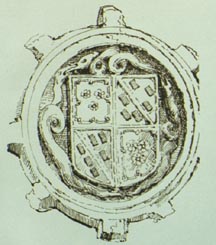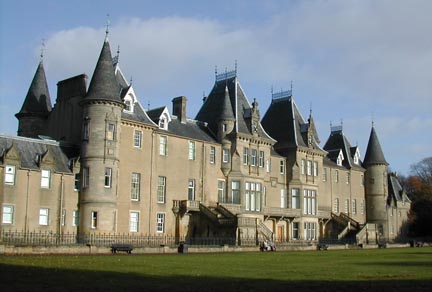The Lairds of Callendar
The Fall of the House of Callendar
Thus far we have seen the Livingstons
in their splendour, let us shortly contemplate them in their decline and
fall. George, fourth Earl of Linlithgow, died in August, 1695, without
issue, when he was succeeded in his titles and estates by his nephew, James,
fourth Earl of Callendar, who, engaging in the rebellion of 1715, was attainted
as Earl of Linlithgow and Callendar, and his whole lands and dignities
forfeited to the Crown. He had married Lady Margaret Hay, daughter of the
twelfth Earl of Erroll, by whom he had one surviving child, Lady Anne Livingston,
married to William, fourth Earl of Kilmarnock, and her eldest son, James,
Lord Boyd, succeeded in her right to the Earldom of Erroll. The great Callendar
property was sold to the York Buildings Company a London incorporation
which speculated largely in the purchase of forfeited estates; but the
"Bairns of Falkirk," as they delighted to style themselves, and the other
vassals and tenants of the Livingstons, were a turbulent and unruly race,
even under their feudal lords, and little inclined to yield "suit and service,"
and far less to pay rents, to an association of London tradesmen. To them,
the York Buildings Company was as unintelligible as the impersonal "John
Company Bahadoor," to the retainers of the Great Mogul. Accordingly, the
Company soon discovered that the only mode of deriving anything from the
estates was to transfer them to the heiress of the family, and a long lease
was therefore granted to the Earl and Countess of Kilmarnock, who were
thus re-established at Callendar, and might, like the Panmure family, under
somewhat similar circumstances, have eventually recovered permanent possession
of their original domains. This lease did not expire till 1773; but long
before that, the Earl of Kilmarnock, not taught wisdom by the ruin of his
predecessor, joined Charles Edward after the battle of Preston, was captured
on the fatal field of Culloden, sent a prisoner to London, and beheaded
on Tower Hill, in 1746. On an eminence, or rather hill, above Callendar
House, now crowned by a circular plantation, tradition still points out
the spot where the last Earl of Kilmarnock, as he rode away to join the
unfortunate Chevalier, lingering behind his armed and mounted followers,
turned his horse round to take a farewell look at the grand old Livingston
estate, which he was never again to see. There is scarcely a finer view
in Britain than that which this spot commands: far in the blue distance
to the North rises the serrated semicircle of the Grampians, forming, with
the broad-topped Ochills, and the waving westward sweep of the Campsie
Fells, and the hills of Saline to the east, a magnificent mountain amphitheatre,
the castled Rock of Stirling glittering in the centre, and the broad expanse
of the Firth of Forth, more like a lake or inland sea than an estuary,
stretching away towards the German Ocean: the rich and beautiful Carse
of Falkirk is in the foreground, studded with villages and church spires;
and here and there an ancient feudal tower. The landscape is indeed wondrously
attractive, combining everything which wood, and water, and rock, and undulating
surface can contribute to diversify and adorn the scene. One can fully
comprehend the sad feelings of the gallant but vacillating Kilmarnock,
as he lingered for the last time over this lovely prospect, and the noble
domain mapped out before him, which he was about to imperil for what he
must then have regarded as the cause of his legitimate sovereign.
The affairs of the York Buildings Company
having fallen into disorder, the Estates of Callendar were brought to judicial
sale, and purchased about 1780 by William Forbes, Esq., a great London
merchant, and a descendant of the family of Forbes of Colquhany in Aberdeenshire.
Mr. Forbes married twice - first, the beautiful Miss Macadam of Craigengillian
in Ayrshire, but without issue; and secondly, Miss Agnes Chalmers of Aberdeenshire,
and dying in 1815, was succeeded by his eldest son, the late William Forbes,
Esq., of Callendar, M.P., and Vice-Lieutenant of the County of Stirling,
who married in 1832 Lady Louisa Charteris, fifth daughter of the Earl of
Wemyss and March, and dying in 1856, was succeeded by his eldest son, the
present William Forbes, Esq., of Callendar, who, in addition to the ancient
Thanedom of Callendar, and the Baronies of Hayning and Almond, the original
domains of the Callendars and Livingstons, is the proprietor of extensive
estates in the counties of Stirling, Ayr, and Kircudbright.
| Of the remaining two ennobled branches of
the House of Livingston, the conclusion is soon told; - the Viscount of
Kilsyth was attainted for high treason in the same year with his chief
(1715), and died at Rome, in January, 1733, and the Peerage of Teviot became
extinct on the death of Viscount James in 1711. With James, Earl of Linlithgow
and Callendar, terminated the whole descendants in the male line of Alexander,
seventh Lord Livingston, and the representation and chieftainship of the
race passed to the family of Westquarter, the descendants of the Honourable
Sir George Livingston, of Ogleface, the fourth son of the sixth Lord Livingston.
This branch, whose fortunes form a very singular episode in the Vicissitudes
of Families, requires a chapter to itself.
The chief residences of the Livingstons were
Livingston, and Midhope Castle in Linlithgowshire, the Castles of Callendar,
Herbertshire, Brighouse, and Haynng in Stirlingshire; and the Viscounts
of Kilsyth possessed, also in Stirlingshire, the strongholds of Colzium
and Kilsyth. |

Armorial Stone Boss from
Old Falkirk Church
|
Of these the largest and most important appears to have been
the Castle of Callendar, - a place of considerable strength before artillery
was invented; and even so late as the time of Cromwell, against whose troops
it made a gallant resistance, a fortress capable of defence.
It then occupied nearly the same site as that on which
Callendar House now stands; it was encircled by a deep moat or fosse, crossed
by a drawbridge, and filled by the springs which now supply the ornamental
sheet of water in the grounds. The space within the moat was surrounded
by a high bastioned and curtained wall, and defended in front by a square
tower or barbacan, the wide gateway of which afforded the only access from
the castle to the park. The greater part of the present House of Callendar
is said to have been built about 180 years ago, by Alexander, second Earl
of Callendar, generally called the covenanting Earl. Herbertshire Castle,
another strong embattled residence, remains to this day; it is one of the
few genuine old Scotch castles still inhabited by a family of the higher
ranks; though a very old building -indeed the date of its erection is not
distinctly known - it is, even now, one of the most comfortable and well
arranged mansions in the county. Callendar House and Herbertshire belong
to Mr. Forbes; they are both in perfect preservation, and fitted up with
all the luxuries and comforts of modern life. The other strongholds of
the Livingstons in Scotland are in ruins; - and for the rest
"The Knights are dust
And their swords are rust,
And their souls are with
The saints, I trust" |
A wide-spreading branch of the old stock
has, however, taken root in the United States of America, and still flourishes
there.
|
This account is from:
Sir Bernard Burke, Vicissitudes of Families.
Remodelled edition. London: Longmans, Green, Reader,
and Dyer, 1869.
Vol. II. Pp. 203-218
with thanks to my cousin John Rees.
|
|
This site posted by Robert
Sewell April 2004
Be sure to visit Robert Sewell's Livingston
of Callendar page
and
The
Sewell Genealogy Site Map
|

